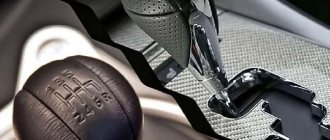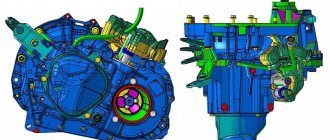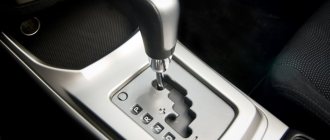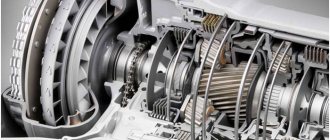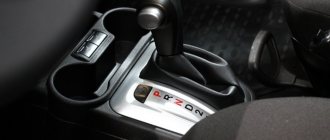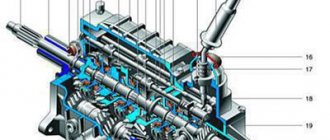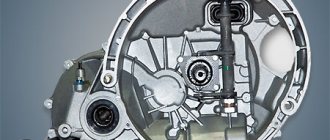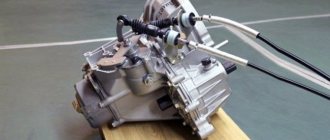The first automatic transmissions began to appear en masse on cars about 30 years ago. Automatic transmissions of that time were controlled through the operation of hydromechanical drives, and simply did not use any electronic solutions in the design. Electronics were unnecessary at that time.
Such a device allowed the machines to provide an amazing service life, which was about 300 thousand kilometers, subject to simple maintenance rules. Modern boxes cannot boast of such a resource, although they have become much more efficient, convenient and functional.
One of the brightest automatic transmissions are adaptive boxes. They have a special design and different operating modes. This allows them to work in optimal mode, depending on certain operating conditions.
Why adaptation is required
Adaptive automatic transmissions differ in that their design provides for the use of a special electronic unit. With its help, the transmission gets used to it, that is, it adapts to the driving style of a particular motorist. This allows you to create an ideal connection between the speed of the power unit and the gear shift.
From here the answer becomes obvious about why this adaptation is needed. This is a way to create the most comfortable and favorable conditions for driving a vehicle in various modes, conditions and when traveling at different speeds.
All this is provided by electronics, which are responsible for several functions simultaneously:
- Accelerating dynamics. The box allows you to create the fastest and sharpest acceleration, or smooth and calm. The automatic transmission monitors the speed at which acceleration occurs most frequently;
- Travel mode. If the position of the foot on the gas pedal does not change, that is, the pressure on the accelerator remains unchanged, the automatic transmission switches to higher gears and saves fuel;
- Acceleration. When the driver tries to accelerate sharply, the box automatically starts the program in sports mode;
- Braking. If the driver suddenly presses the brake pedal to the floor, which is considered sports braking, the electronics force the transmission to drop down several gears at once;
- Wear. In parallel, the task of the adaptive box is to monitor the degree of wear of the assembly elements.
All this allows you to make the operation of the box clear, thoughtful and adapted to a person’s driving style. This makes it possible to understand in many ways what adaptive automatic transmission means and what its main features are.
But it is necessary to understand in more detail the essence of such equipment. To really understand what this adaptive automatic transmission is, you should study its structure and operating modes.
About the main types of gearboxes
It is an integral part of any car. The gearbox, or gearbox for short, is involved in transmitting torque from the engine to the wheels. In fact, in its simplest form, it is a gearbox with spur gears, designed to change the amount of torque coming from the engine. However, a modern gearbox and its design bear little resemblance to such a gearbox. Now there are several different versions of it that exist and are used on cars:
Manual transmission (manual transmission). It most closely corresponds to the traditional design, in which the transmitted torque is changed manually, for which the driver depresses the clutch and changes the position of the control lever, as a result of which the gears in mesh change. It is stepwise, i.e. the value of the torque coming from the engine changes by some amount in steps. The advantage of such a gearbox is its ease of manufacture, reliability and the ability for the driver to select the desired vehicle driving mode.
Automatic transmission (automatic transmission) or, as it is also called, automatic. It is a further development of the manual transmission. The automatic transmission changes gears without driver intervention. In this case, the magnitude of the transmitted torque also changes stepwise. There are various design options for how an automatic transmission is implemented, but the stepwise principle of changing the torque coming from the engine is, as a rule, preserved.
The machine provides the driver with:
- additional comfort when driving a vehicle, because there is no need to be distracted by gearshift changes;
- timely changes in transmitted torque;
- reduced fuel consumption and good acceleration dynamics.
- A CVT transmission can be considered one of the varieties of both automatic and independent gearboxes. It carries out a stepless change in the magnitude of the torque in accordance with the current load and developing driving conditions.
These types of gearboxes are most often installed on modern cars, but such devices can be completely different, significantly different from those described. It is worth keeping in mind that the other side of the complication of the original design will be the increased cost of new units, as well as the increasing costs of their maintenance.
Device Features
Much in terms of design and device depends on the specific automaker. Competition forces the introduction of some proprietary solutions that distinguish the box of one manufacturer from another.
But if we talk about what an adaptive automatic transmission is, then we should take into account certain similarities between all similar automatic transmissions. The first step is to use a torque converter. It includes paddles mounted on 3 wheels. Gear drives are also used, the majority of which are planetary.
The true difference and the main essence of adaptive devices lies in the electronics. The electronic units have approximately the same design, some look almost identical. But each manufacturer has its own set of programs, filling and electronic brains.
It wouldn’t hurt to compare a regular machine gun and an adapted one. In the first case, we are talking about pre-programmed speed switching. Yes, all manufacturers may have slightly different approaches to programming, but the essence always remains the same. Switching occurs at approximately 2500 rpm. When this mark is reached, a transition occurs from one speed to another. At the same time, there is no need to talk about economical or increased speed in standard operating mode.
To change the switching program on conventional automatic machines, manufacturers provide a transition to different modes such as economical, sports, off-road, etc. But this does not happen automatically. The box changes the style of its operation, otherwise it changes gears only after manually changing the mode. This is not an adaptation, just a manual adjustment. To return to the economy mode again or to transfer the box to urban operating conditions, you will need to manually switch from one mode to another.
A distinctive feature of the adaptive transmission is the absence of various buttons and settings, as well as all kinds of modes that need to be turned on and switched. The electronics remembers your driving style and regulates everything necessary independently. This explains why adaptive devices use a minimal number of buttons and switches.
If the driver prefers economical and careful driving, the box will consider this, understand it and work in the appropriate mode. If the driver prefers more aggressive driving, then gear shifting will occur at higher speeds.
Education
Motorists who have experience in operating cars with an adaptive transmission note that during long periods of downtime in traffic jams, the operation of the automatic transmission changes; it ceases to be the same as before getting into heavy traffic.
In fact, the box changes its mode. When you press the gas pedal, the acceleration dynamics are significantly reduced; it is not possible to accelerate normally, as the driver is accustomed to under normal conditions. All this is due to the fact that the electronics adapt to traffic jams, where minimum speeds, slight acceleration and short dashes followed by braking are needed. The automatic transmission has switched to a longer shift mode, which is aimed at reducing the number of shifts themselves and reducing wear on transmission elements.
Automatic transmission training
As I mentioned above, training depends on many parameters, as well as on the very structure of the machine and its electronics (algorithms).
On one, you just have to pull out of a traffic jam and press the gas for a few minutes (dynamic driving) and it will switch from a vegetable to a sporty ride.
But there is training when you need to carry out special manipulations, because the algorithm is calculated based on the last, say, 200 kilometers. You bought such a car, but it doesn’t work for you, it’s better to reset everything to factory settings.
- The first option is the dealer, he will be able to reset the adaptation. And even upload other factory firmware. BUT this is not the case for all manufacturers.
- As they call it on the forums – “collective farm training”. This is when several different manipulations seem to reset the adaptation, for example - turn on the ignition - hold the gas pedal (30 seconds) - then the brakes (30 seconds) - release and turn off the ignition. It is reliably known that this is how Mercedes is chipped in. Here is an example video.
- There is another training option - it will be of interest to owners of AVEO (T300), and I think also to other Chevrolets that have a 6T30/40/45 automatic. They have a manual mode - the essence of which is to switch to “M”, then we change gears as we need, that is, so that first – second – third and others shift faster, we press the “plus sign” on the lever, that is, we work instead of an automatic transmission. The automatic transmission remembers the algorithm and after you return to the normal “D” mode (after 20 - 30 minutes), the shifts will be very similar to your manual ones.
Operating modes
As noted earlier, the automatic adaptive transmission adapts to the driver's specific driving style. Depending on acceleration, braking, acceleration, intensity of operation of the gas and brake pedals, the electronics selects the required optimal mode.
Moreover, the operation of such transmissions can be carried out in several of the most common modes:
- economical;
- sports;
- winter
Each of them has its own characteristics.
- Economical operating mode. If the driver adheres to a moderate driving style with his vehicle, the electronics switches to economy mode. The main objective of this mode is maximum fuel economy. During operation of the car, smooth and gradual acceleration is observed, the car does not move away when you press the gas pedal. Mostly the automatic transmission electronics select lower gears. A relevant mode for those who often drive in urban environments, are forced to sit in traffic jams, face heavy traffic and comply with speed limits;
- Sports mode. For more aggressive drivers who like to accelerate quickly and drive at high speeds, the electronics provide the option of switching to a sport program. It is aimed at forced control, the fastest possible acceleration, and excellent dynamics. In addition to quickly accelerating, in this mode the car will also brake quickly. When switching to the vehicle's sport mode, the adaptive transmission extracts full power from the engine. As a result, the car starts quickly and actively gains maximum speed. In parallel, this leads to increased fuel consumption. There is no longer any talk about any priority for saving fuel;
- Winter operation mode. An extremely useful and effective option for adaptive automatic transmission programming. With its help, the car adapts to movement on the road surface, which is characterized by the presence of a layer of snow or ice. Special programs allow the car to start moving almost without slipping. At the same time, acceleration and braking are moderate, without sudden jerks and kicks. At the same time, the program includes the possibility of an emergency stop. Here the braking is carried out by the engine. This function is aimed at reducing the braking distance when braking on a slippery surface. In winter mode, there is no clear priority for automatic transmission gears. The only exception can be called the start. In this state, the adaptive gearbox prefers to start off primarily in 2nd or 3rd gear.
These are just 3 of the most common and frequently used modes in adaptive automatic transmissions.
But automatic transmission manufacturers are constantly working to improve and improve their designs and the electronics themselves. This makes it possible to introduce new modes and additional features aimed at making the control of his vehicle as comfortable, safe and consistent with the needs of the motorist as possible.
Adaptation time
Car enthusiasts are quite rightly interested in the issue of adaptation speed. That is, the time period required for the transmission to get used to and adapt to certain operating conditions.
The adaptation time directly depends on the specific manufacturer of the boxes and the electronics used. Boxes can be roughly divided into 2 categories:
- Automatic transmission, where adaptation takes literally a few minutes or occurs after several kilometers traveled. The driver drives a certain distance or drives for some time in a calm or aggressive mode. The machine gets used to this and switches to the appropriate operating program;
- Other transmissions use accumulated information. They accumulate algorithms, collecting data over a fairly impressive period of time or over a large number of kilometers. Some boxes can adapt based on the last 300-1000 kilometers. Having stored the information in the electronic unit, the computer begins to switch between modes, depending on the specific situation. Such automatic transmissions are the most difficult to learn.
Each category of adaptive machines has its own advantages. The first can quickly get used to new conditions, but at the same time it often provokes discomfort in the event of a sudden change in operating mode. In the second situation, you need to wait longer for full adaptation, but then the box will clearly understand how to behave.
Advantages and disadvantages
There is no limit to perfection. And the current adaptive boxes are certainly far from ideal. It will still take quite a lot of time to achieve optimal results in the operation of these transmissions.
If we talk about current adaptive machines, we can highlight several main advantages:
- The ability to create comfortable conditions during the operation of the vehicle;
- Speed switching is carried out in certain programmed algorithms, when choosing one of which the speed of movement, the condition of the surface, the intensity of pedaling, etc. are taken into account;
- Modes change independently. The driver does not need to press any buttons or levers;
- Minimum number of buttons and controls on the box;
The ability to reduce fuel consumption, which is ensured by the selection of gears and operating modes.
But not everything is so perfect. Adaptive automatic transmissions have their drawbacks. The main disadvantage is the imperfection of the adaptation system, which is not always able to correctly adapt to the driver’s requirements. This is clearly manifested when one driving mode is replaced by another. For example, when the driver was moving in slow, dense traffic, and then drove onto an open highway and wanted more dynamics. Or vice versa. It takes some time to rebuild and adapt, sometimes measured in several minutes or kilometers.
Also, the adaptive system does not always show its best side when driving on bad roads, where there are rather sharp transitions from normal surfaces to various uneven surfaces, bumps and holes that need to be avoided and maneuvered.
Another drawback is the issue of maintenance. In Russian conditions, there are some problems with maintenance and finding spare parts. Since adaptive automatic transmissions are actually a type of automatic transmission, but with more complex electronics, finding and purchasing some parts can be problematic. This requires more time and financial resources.
Automatic transmission
An automatic transmission involves automatic gear shifting, which does not require driver participation in this process. That is, if with a manual transmission the car owner must press the clutch and work with the shift lever to change the speed mode, with an automatic transmission the car independently selects a gear.
As a rule, with any installed gearbox, a step mechanism for changing the torque coming from the engine is retained.
Care instructions
There is no point in perceiving adaptive transmissions as something unusual, new and previously unseen. These are the same automatic transmissions, but with expanded capabilities and sophisticated electronics.
Although the electronic filling has complicated the box itself as an electronically dependent unit, in some places the design has been simplified. After all, on such automatic transmissions, various buttons and switches for different modes, which on conventional automatic transmissions were turned on and off manually, have disappeared.
Therefore, there are no special care recommendations intended specifically for adaptive boxes. They are looked after in the same way as any automatic transmission. It is necessary to periodically change or add transmission lubricant, as recommended by the manufacturer. If you change the oil on time and choose high-quality compounds, most problems and troubles can be prevented.
Try not to overload the automatic transmission, change the consumable fluid on time, according to the rules prescribed by the car manufacturer, monitor the condition and quantity of transmission oil. Periodic prevention is much simpler and cheaper than subsequent repair of breakdowns. In the case of adaptive transmissions, it is recommended not to bring them to a state of emergency, requiring complex repairs and replacement of elements. They are expensive, and there are some problems finding them on the domestic market. Some components have to be ordered and waited several weeks for delivery. You will not be able to operate the car all this time if the breakdown is really serious.
So far, the attitude of car enthusiasts towards adaptive automatic transmissions is quite ambiguous. They allow you to obtain certain advantages, increase comfort and efficiency. At the same time, such automatic transmissions do not always quickly and adequately respond to changes in operating mode and driving style, which causes delays that provoke some discomfort and inconvenience for drivers. The system is complex, but not fully thought out and perfected. Manufacturers have a lot of work to do so that the adaptive machine can quickly and accurately adapt to specific conditions.
Problems during the procedure
Adaptation of automatic transmissions became possible thanks to the emergence of complex electronic systems that continue to be improved and developed. The complexity of these systems, aimed at increasing traffic comfort and safety, is fraught with potential risks and possible problems.
Problems that arise during the operation of an automatic transmission or its adaptation are in most cases associated with the operation of the ECU, with failures of its program logic circuits or technical elements. The causes of the latter may be short circuits as a result of damage to the insulation or integrity of the housings, overheating or the ingress of moisture, oils, dust, as well as voltage surges in the vehicle’s on-board network.


